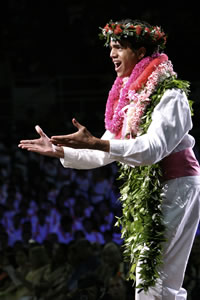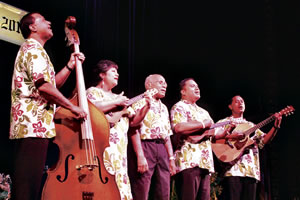‘One Voice’ Hits The Big Screen

|
A film documentary about Kamehameha’s Song Contest soars into theaters and shows what it’s really like to stage a high school musical of epic proportions
It took a year, but the award-winning documentary about the Kamehameha Schools Song Contest finally moves forward imua! this Friday when it makes its theatrical release at Consolidated Theaters.
Initially screened at the 2010 San Diego Asian American and Hawaii International film festivals, where it ultimately captured Best Documentary honors One Voice takes viewers on a journey with 10 high school student song leaders, all of whom are attempting to lead their respective classes to victory at the choral music competition. Along the way, these affable song leaders experience a roller coaster of emotions from cirrus-cloud highs to earthcore lows as they implore classmates in rehearsal after rehearsal to come together in perfect harmony, in one voice.
The final product is a full-length film that not only wins audiences over (and leaves many alumni, including yours truly, misty-eyed), but effectively captures the fierce spirit of the decades’ old Hawaiian cultural celebration, performed annually by nearly 2,000 students in a capella fashion.
“I don’t think any of us realized how big the film would become. We all kind of brushed it off,” says Kahala Rowe, a 2008 graduate and one of the senior song leaders featured in the documentary. “But look at it now the film has totally flourished. It’s just a blessing to know that something that started in our choral room is now on the big screen.”
Musical Notes caught up with noted hula filmmaker and One Voice director Lisette Flanary, a longtime resident of New York City who recently relocated to Oahu, and got her to discuss the documentary in greater detail.
MN: What attracted you to such a project?
LF: I was drawn to it because of my interest in Hawaiian music and language. For me, it was inspiring to see this film through the lens, or the point of view, of the song directors.
MN: How difficult was it to get high school students to stop paying attention to a camera crew that was with them almost from sunup to sundown?

|
LF: It was tough at first. You have to realize that it was probably very weird for these kids to suddenly have cameras following them to English and Hawaiian Language classes, and riding the busses with them to school at 5 o’clock in the morning. In fact, the biggest challenge for me was trying to convince the students that this wasn’t going to be a reality show project, but an actual project aimed to capture the spirit of the competition.
MN: At what point did the students finally stop performing for the cameras?
LF: For me, the point where most people got comfortable was when we got to go and visit them at home with Tutu, Mom and Dad. That’s when they finally loosened up. They also got to spend a lot of time with me and got to know who I was and what I hoped to do with the film. Any time anyone invites you over to their home and asks you to spend time with their family, it’s a huge honor.
MN: The filming wrapped up in late spring of 2008, and then it took another year for you to finish postproduction work. During that period, you made it a point to keep the school and students not only informed of the film’s progress, but to show them some of the editing that was being made. Why did you do that?
LF: It was very important to me to share the different rough cuts with the school, with the students who were in the film and with the parents so that they could understand what the film was going to be like, and to get their feedback throughout the process. It’s a little unusual for most documentary filmmakers to show the film to the subjects before the finish, but it was important to my process because I wanted to really honor Kamehameha Schools and make sure everyone was really proud of the film.
SMALL-KINE notes:
Speaking of Kamehameha, the Class of 1983 is hosting a “Welcome to the ‘80s Flashback” this Saturday from 5 to 10 p.m. at Aloha Tower Marketplace. Drop in and enjoy heavy pupus, a silent auction, lucky number drawings, ‘80s music and live entertainment by Nesian N.I.N.E and The Kaneakua Ohana. Money raised will help pay for next year’s alumni luau. For tickets and more information, call 954-7062 ...
Song contest isn’t the only local Hawaiian music competition showcasing beautiful voices. In its 27th year, “Ka Himeni Ana” features amateur Hawaiian music groups singing in the nahenahe style and accompanied by unamplified acoustic instruments. Aside from last year’s winner, Hoopii, other talented performers have used the competition as a launching pad to greater things, including 1998 winners Alea, made up of Kale Hannahs, Ryan Gonzales, Chad Takasugi and Kalai Stern. “It has always been a challenge to encourage budding entertainers to overcome their shyness and stage fright and enter the competition each year, and of those are many that have gone on to greatness,” says Rick Towill, son of event founder Richard Towill. “Overall, it is heartwarming to see how traditional Hawaiian singing has remained as a vibrant part of our island culture.” This year’s competition, which will honor the late Aunty Genoa Keawe and her husband, Edward, takes place Saturday evening at historic Hawaii Theatre. The sweet harmonies begin at 7.
Most Recent Comment(s):














